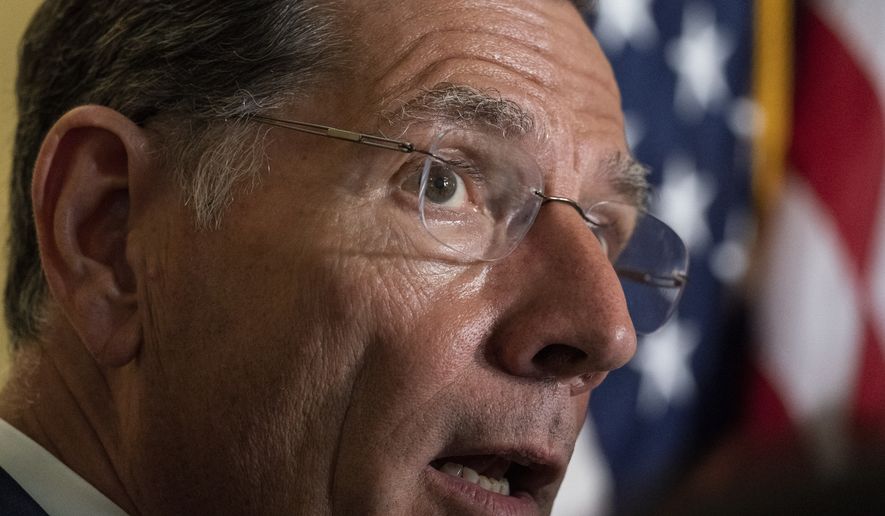Sen. John Barrasso of Wyoming said Friday he would oppose President Biden’s nominee to head the Bureau of Land Management over her early ties to “eco-terrorists,” referring to her stint with Earth First!, a radical environmental group.
Tracy Stone-Manning, Mr. Biden’s pick to serve as BLM director, was affiliated with the eco-group three decades ago while attending graduate school at the University of Montana, serving as an editor of the group’s “radical environmental journal” and testifying at a tree-spiking trial.
“Tracy Stone-Manning collaborated with eco-terrorists,” Mr. Barrasso, the ranking Republican on the Energy and Natural Resources Committee, said in a statement to The Washington Times.
“She worked with extreme environmental activists who spiked trees, threatening the lives and livelihoods of loggers,” he said. “While she was given immunity from prosecution to testify against her companions in court, her actions were disgraceful. This clearly disqualifies her from serving as the next director of the Bureau of Land Management.”
His opposition comes with Republicans raising concerns about her activist background as well as a loan of between $50,000 to $100,000 she received in 2008 while working for Sen. Jon Tester, Montana Democrat, and finished paying off in 2020.
Sen. Roger Marshall, Kansas Republican, identified the lender as Democratic donor and Montana developer Stuart Goldberg, and asked whether she received “special treatment” with the 6% interest rate, significantly less than the 11% being charged on average at the time for consumer personal loans.
The Times has reached out to Ms. Stone-Manning for comment.
Ms. Stone-Manning boasts a blue-chip resume of public service in Montana — she served chief-of-staff for Montana Gov. Steve Bullock and headed the state Department of Environmental Quality — but she got her start in environmental activism with Earth First!, a radical collective associated with civil disobedience, direct action and industrial sabotage.
The group was co-founded in 1980 by Dave Foreman, an activist who the FBI arrested in 1990 on charges related to a plot to target an Arizona power line tower. He said he was not involved but pleaded guilty to a misdemeanor charge and served no jail time, according to the Aspen Daily News.
Ms. Stone-Manning’s involvement appeared to run for about three years: She said in court testimony that she became affiliated with the group in 1988, and the June 1991 edition of the Earth First! journal, which features a wrench and hammer on the masthead, listed her as an editor.
In the 1993 conspiracy trial in Idaho, she said she got to know several men who were later accused of driving metal spikes into trees, known as tree-spiking, to disrupt a timber sale in the Clearwater National Forest near Powell, Idaho.
One of the men, John Blount, asked her in April 1989 to mail an anonymous letter to the Forest Service warning that 500 pounds of bridge spikes had been driven into trees.
In her court testimony, she said she took the letter and retyped it on a typewriter she rented from the university, changing some spelling errors and deleting some profanity, then mailed it a few days after receiving it.
Why mail it?
“Because I wanted people to know those trees were spiked. I didn’t want anybody getting hurt as a result of trees being spiked,” she said in the court transcript.
Asked why she retyped it, Ms. Stone-Manning said she did so because “I didn’t want it on my personal computer.”
Two of the men, Arvid E. Hartley and Neil K. McLain, pleaded guilty to misdemeanor tree-spiking charges and agreed to testify against three others, including Mr. Blount, according to the 1993 Associated Press report.
In a 2013 interview with the Missoulian, Ms. Stone-Manning offered more details, saying that after Mr. Blount handed her the letter, she realized “now my fingerprints were all over it.”
“The easy thing to do would have been to burn that letter and walk away and not be associated with it, but that was the wrong thing to do because trees were spiked and somebody could be hurt when the loggers were sent in,” she said. “So I mailed the letter.”
The retyped letter from “George Hayduke” said that 11 people were involved in the tree-spiking and that the “sales were marked so that no workers would be injured,” adding that he would pay them $1 for the sale, but “you would have to find me first and that could be your WORST nightmare.”
Ms. Stone-Manning said at the trial that she was unaware of other tree-spiking incidents, although Earth First! made no secret of its eco-sabotage sympathies.
In his book, “Ecodefense: A Field Guide to Monkeywrenching,” Mr. Foreman described “the proper way to spike a tree and explains why, when decommissioning a bulldozer, pouring sand into its gas tank is much more effective than pouring sugar,” the Los Angeles Times reported in 1990.
Mr. Foreman later stressed that the technique was meant to stop logging, not harm people, after California logger George Alexander was badly injured in 1987 when a bandsaw hit a spike embedded in a log. The broken blade went flying, hitting him in the head and slashing his face.
The June 1991 Earth First! journal on which Ms. Stone-Manning is listed includes a comic about tree-spiking and an ad for T-shirts that feature the slogan “Not One More Tree” with a spike running through it.
The publication, posted on the Environment & Society Portal, also includes a warning about discretion: “Although we do not accept the authority of the hierarchical state, nothing herein is intended to run us afoul of its police power.”
The Senate Energy and Natural Resources Committee held Tuesday a hearing on Ms. Stone-Manning’s nomination to head the agency, which oversees 245 million acres of federal land primarily in the West.
She was introduced by Mr. Tester, who called her “a proven leader with a track record of working across the aisle to get things done.”
• Valerie Richardson can be reached at vrichardson@washingtontimes.com.




Please read our comment policy before commenting.